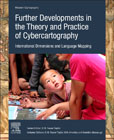
Further Developments in the Theory and Practice of Cybercartography
Taylor, D.R. Fraser
Anonby, Erik
Murasugi, Kumiko
Further Developments in the Theory and Practice of Cybercartography is the third, substantively updated edition of a classic text on cybercartography, presenting new and returning readers alike with the latest advances in the field. It continues to examine the major elements of cybercartography and embraces an interactive, dynamic, multisensory format with the use of multimedia and multimodal interfaces. Material covering the major elements, key ideas, and definitions of cybercartography is newly supplemented by several chapters on two emerging areas of study: International Dimensions and Language Mapping. In addition to expanding upon the work done with indigenous communities in the previous edition, this volume's broader international focus includes developments in Mexico, Brazil, Denmark, Iran, and Kyrgyzstan, demonstrating how insights emerge when cybercartography is applied in different cultural contexts. Meanwhile, other chapters contain case studies by a talented group of linguists who are breaking new ground by applying cybercartography to language mapping, providing new ways of understanding the distribution and movement of language and culture. Further Developments in the Theory and Practice of Cybercartography is a critical resource for university faculty, graduate students, and advanced undergraduates in cartography, geography, linguistics, and rural community development or indigenous studies, as well as policymakers at the local level in Mexico, Brazil, Canada, and indigenous communities. Highlights the relationship between cybercartography and critical geographyIncorporates the latest developments in the field of cybercartography, including International Dimensions and Language MappingShowcases legal, ethical, consent, and policy implications of mapping local and traditional knowledge INDICE: Part 1: The Evolution of Cybercartography 1. Introduction: Beyond the Cyber in Cybercartography: Some New Dimensions 2. The Theory and Practice of Cybercartography: An Introduction 3. Cybercartography: A Multimodal Approach 4. Some Recent Developments in the Theory and Practice of Cybercartography: Applications in Indigenous Mapping: An Introduction 5. Cybercartography and Volunteered Geographic Information 6. Further Developments in the Theory and Practice of Cybercartography: Exploring Web 2.0 and Participatory Software for Building Geolocated Narratives 7. A Spatial Typology of Cinematic Narratives 8. Considerations for Informed Consent in the Context of Online, Interactive Atlas Creation 9. Cybercartography and Traditional Knowledge: Responding to Legal and Ethical Challenges 10. Cybercartography for Education: The Application of Cybercartography to Teaching and Learning in Nunavut, Canada 11. The Preservation and Archiving of Geospatial Data and Cybercartography as a Proactive Preservation 12. The Future of Cybercartography 13. Developments in the Nunaliit Cybercartographic Data Management Platform 14. Cybercartography and Critical Cartography (New) Part 2: International Dimensions and New Applications 15. Storytelling with Cybercartography: The William Commanda Story 16. Cybercartography and the Historical Geography of Roman Britain 17. Digital Return of Inuit Ethnographic Collections using Nunaliit 18. Cybercartography as a Transdisciplinary Approach to Solve Complex Environmental Problems: A Case Study of Kumeyaay Peoples of Baja California, Mexico 19. The Territories of the Indigenous Peoples of Baja California, Mexico: Semiotic Dimensions in the Study of Landscapes 20. The Potential of Cybercartography in Brazil: A Cybercartographic Atlas for Lencois Maranhenses National Park, Maranhao State, Brazil 21. Cybercartography for Governance: Mapping Traditional Ecological Practices in Naryn Province of Kyrgyzstan Part 3: New Approaches to Language Mapping 22. Expanding the Boundaries of Language Mapping 23. Identification and Representation of Complementary User Perspectives in a Language Atlas 24. The Utility of Cybercartography in Indigenous Language Education 25. Applying the Nunaliit Framework to the Visualization of Complex Linguistic Variation 26. Cybercartography for Ethnophysiographic Atlas Part 4: The Future of Cybercartography Conclusions: What We Have Learned and What Lies Ahead
- ISBN: 978-0-444-64193-9
- Editorial: Elsevier
- Encuadernacion: Rústica
- Páginas: 520
- Fecha Publicación: 01/11/2019
- Nº Volúmenes: 1
- Idioma: Inglés
